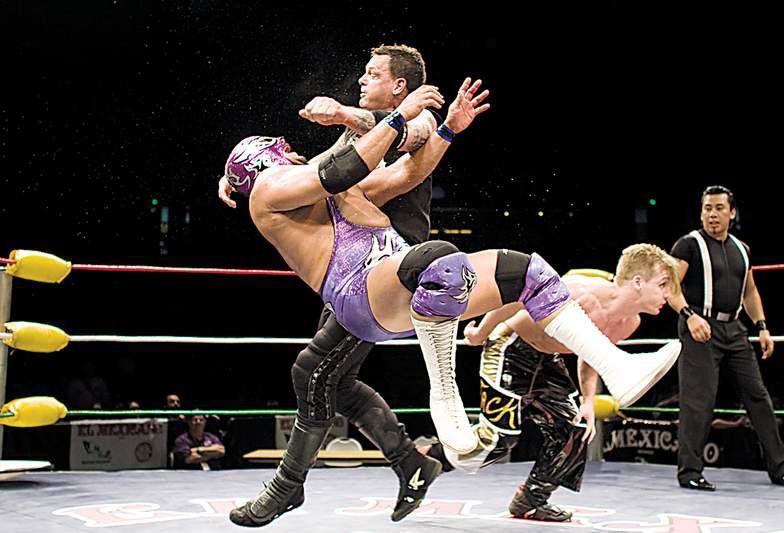Immigration politics invade wrestling ring
Published 5:00 am Sunday, May 10, 2009

- Lucha Libre AAA wrestler Vampiro clotheslines Silver King at a March match in Sacramento, Calif. Though born in Canada, Vampiro usually champions the Mexican side against La Legion Extranjera, mostly white wrestlers who openly scorn the immigrant crowds.
SACRAMENTO, Calif. — It was billed as an invasion. On a chartered tour bus carrying two dozen fighters, promoters of the wrestling style known as lucha libre rode through California last month to stage matches replete with the colorful masks, sexual slapstick and frenetic, acrobatic fighting style that have propelled their sport to rival soccer for popularity in Mexico. The headliners were long-haired, muscle-bound and handsome, promising crossover material for the American market.
But in the heart of the fight card, a deeper conflict played on the racial tensions and stereotypes of a downtrodden immigrant audience. Among the wrestlers, the vilest of the vile were the members of La Legion Extranjera, the Foreign Legion, gringos who openly disparaged the spectators, their language and their country. The invasion, in this sense, referred to the chance for the Mexican heroes to drive out the Foreign Legion.
Trending
Just as American wrestling leagues enjoyed broad popularity in the waning days of the Cold War with villainous Soviet characters like Nikolai Volkoff and Krusher Khrushchev, the lucha libre promoters have tailored their story line to the times. With immigration policy and the violent Mexican drug wars consuming the attention of policymakers, the cartoonish confrontation of north and south in the ring has found an eager audience in California, home to 37 percent of the nearly 12 million Mexicans estimated by the nonprofit Migration Policy Institute to be living in the U.S.
For the invasion tour, the promoters scheduled five matches a night. The theme was a marketing ploy doubling as a plot. In authentic lucha libre, the action merely punctuates an operatic narrative of inconstant loyalties, complex alliances and dark brooding.
The opening match included Pimpinela, a transvestite who humiliates opponents with flamboyant smooches, and his partner, Mascarita Sagrada, a masked acrobat who stands about 4 feet 6 inches. The finale pitted the stars La Parka and Mesias against teams known as the Black Family and the Psycho Circus.
Between those matches, the centerpiece featured a showdown with the Foreign Legion. In the ring, the conflict unfolded in terms beyond simple racial caricature. Several members of the legion, including their leader, are Latino traitors.
And the champion of the Mexican side, Vampiro, was born Ian R. Hodgkinson, a white Canadian. Now 41, Hodgkinson played music in the Los Angeles glam-rock scene of the 1980s before reinventing himself as a wrestler. When he first crossed the border, he was wearing his makeup thick and his hair purple. He dressed in black, covered his upper body in 84 tattoos and entered the ring to AC/DC’s “Back in Black.”
Vampiro has nursed his feuds across the better part of two decades, to the point where he can make his appearances in street clothes and a barber-shop haircut. His adventures are storied. His loyalties are known. His character symbolizes more than the sum of his allegiances.
Trending
On a Sunday in San Jose, Calif., as the lights of a hockey arena dimmed, a wrestler called Jack Evans entered the ring with a microphone. He was young, white and muscular, an unmistakable member of the Foreign Legion.
“Hey, San Jose, how’s it going?” Evans said. “I’m just kidding; I don’t care what you think. This is my country.”
To a chorus of boos, he went on: “I get to teach the Mexican people how to be what they always wanted to be, Americans.”
Switching to Spanish, which he called “your dirty little language,” Evans told the spectators they were too stupid to learn English and become true Americans. Silver King, a turncoat member of the Foreign Legion from Torreon, Mexico, took his side.
By the time it was all done, the villains were pummeled, the tectonic guitar crunch of Vampiro’s theme song was proclaiming the victory of the Mexican side, and hundreds of children were standing in line for $20 Polaroid photographs.








